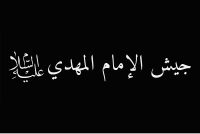| Mahdi Army جيش المهدي | |
|---|---|
 | |
| Leaders | Muqtada al-Sadr |
| Dates of operation | 2003–2008 |
| Headquarters | Najaf, Kufa, Sadr City |
| Active regions | Iraq |
| Ideology | Iraqi nationalism Sadrist Thought Qutbism Shia Islamism[1] Shia Jihad[2] Anti-Coalition Anti-Americanism Anti-LGBT Anti-Zionism Anti-Sunnism[3] |
| Status | Dissolved |
| Size | 60,000 (2008)[4] |
| Allies |
|
| Opponents | |
| Battles and wars | Iraq War |
The Mahdi Army (Arabic: جيش المهدي) was an Iraqi Shia militia created by Muqtada al-Sadr in June 2003 and disbanded in 2008.[9]
The Mahdi Army rose to international prominence on April 4, 2004, when it spearheaded the first major armed confrontation against the US forces in Iraq from the Shia community. This concerned an uprising that followed the ban of al-Sadr's newspaper and his subsequent attempted arrest, lasting until a truce on June 6. The truce was followed by moves to disband the group and transform al-Sadr's movement into a political party to take part in the 2005 elections; Muqtada al-Sadr ordered fighters of the Mahdi army to cease fire unless attacked first. The truce broke down in August 2004 after provocative actions by the Mahdi Army, with new hostilities erupting.[citation needed] The group was disbanded in 2008, following a crackdown by Iraqi security forces.
At its height, the Mahdi Army's popularity was strong enough to influence local government, the police, and cooperation with Sunni Iraqis and their supporters. The group was popular among Iraqi police forces. The National Independent Cadres and Elites party that ran in the 2005 Iraqi election was closely linked with the army. The Mahdi Army was accused of operating death squads.[10][11]
The group was armed with various light weapons, including improvised explosive devices (IEDs). Many of the IEDs used during attacks on Iraqi security forces and Coalition forces used infrared sensors as triggers, a technique that was used widely by the IRA in Northern Ireland in the early-to-mid-1990s.[12]
The group was semi-revived in 2014 as Saraya al-Salam in order to fight against the Islamic State of Iraq and the Levant and was still active as of 2016. It participated in the recapture of Jurf Al Nasr and the Second Battle of Tikrit.
- ^ "Mapping Militants: Mahdi Army". cisac.fsi.stanford.edu. Stanford University. May 2019. Retrieved 5 November 2019.
- ^ "Mapping Militants: Mahdi Army". cisac.fsi.stanford.edu. Stanford University. May 2019. Retrieved 5 November 2019.
- ^ Steele, Jonathan. "40 die in Baghdad massacre as Shia militia go on rampage". The Guardian. Retrieved 9 July 2006.
- ^ Dralonge, Richard (2008). Economics and Geopolitics of the Middle East. Nova Science Publishers, Incorporated. p. 61. ISBN 9781604560763.
- ^ "Mapping Militant Organisations, Mahdi Army". Stanford University.
- ^ "اسرار من معركة الفلوجة عام 2004 كيف تعاون مقتدى الصدر مع البعثيين والتكفيريين وقاتل الى جانبهم". 23 May 2008.
- ^ "Mahdi Army | Mapping Militant Organizations".
- ^ "Mahdi Army | Mapping Militant Organizations".
- ^ "The immutable Muqtada al-Sadr loses a battle against Iran". atlanticcouncil.org. 22 June 2022. Retrieved 8 January 2023.
- ^ "Iraq's death squads: On the brink of civil war". The Independent. Archived from the original on 30 April 2008. Retrieved 10 April 2015.
- ^ "Al-Sadr's Weakening Grip on the Mahdi Army". Terrorism Monitor. The Jamestown Foundation. Archived from the original on 16 October 2006. Retrieved 10 April 2015.
- ^ Harkin, Greg; Elliott, Francis; Whitaker, Raymond (16 October 2005). "Revealed: IRA bombs killed eight British soldiers in Iraq". The Independent. London. Archived from the original on 9 July 2008. Retrieved 12 May 2010.